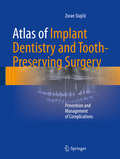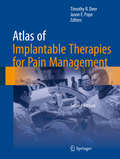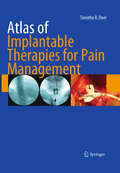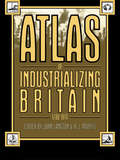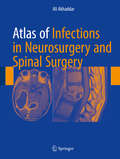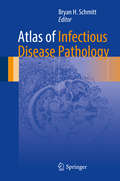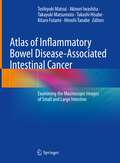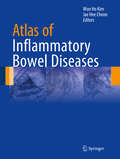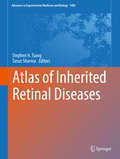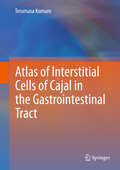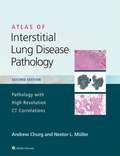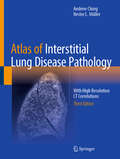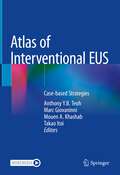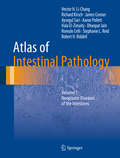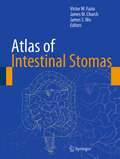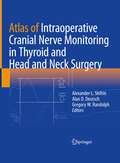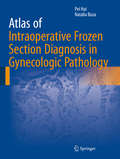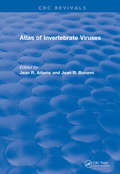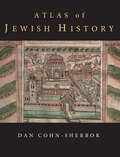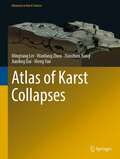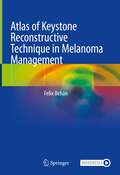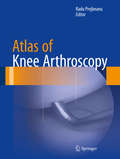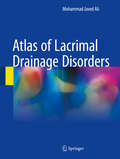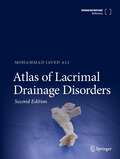- Table View
- List View
Atlas of Implant Dentistry and Tooth-Preserving Surgery: Prevention and Management of Complications
by Zoran StajčićWeighs the pros and cons of tooth-preserving surgical procedures against implant dentistry.<P> Offers extensive guidance on the etiology, prevention, and management of complications.<P> Includes numerous full color clinical photos of step-by-step surgical procedures.<P>This atlas is unique in comparing the two disciplines of dental implant surgery and tooth-preserving surgery with respect to common procedures, problems, and failures and in providing excellent guidance on the prevention and management of complications. The etiology of a wide variety of implant-related and non-implant-related complications and failures is carefully explained. Since many complications have their roots in oral and periodontal surgical maneuvers, these maneuvers are themselves discussed and extensively illustrated. The most frequently used tooth preservation procedures are also fully described, with emphasis on correct surgical technique as a means to avoid complications. The use of these procedures is constantly weighed against the effects of tooth removal and insertion of dental implants. The text is complemented by the inclusion of a substantial number of helpful references. While the atlas is intended primarily for dentists involved in outpatient implant dentistry and oral surgery, oral and maxillofacial surgeons will also find the descriptions of innovative techniques or maneuvers to be of interest, including those relating to the selection of incision and flap design and the sinus floor elevation techniques.
Atlas of Implantable Therapies for Pain Management
by Jason E. Pope Timothy R. DeerFrom reviews of the First Edition: "For the practitioner new to the field of implantable therapies, this book shows the scope of this particular branch of pain medicine. It is full of good advice on techniques and how to avoid complications. " British Journal of Clinical Pharmacology "All practicing pain physicians, whether their background is in anesthesia or neurosurgery, will find [this atlas] very useful. . . beautifully written and well-illustrated with x-ray images and pictures. . . a must-read for every pain fellow and a very useful one for every pain physician. " Doody's Review Service Now in its Second Edition, this atlas remains an essential guide to the treatment of pain using neuromodulation and is written for all implanters, from beginners to the most advanced practitioners. It has been significantly expanded with many brand new chapters and figures and thoroughly updated to address new techniques, targets, waveforms, and concepts that have emerged since publication of the last edition and now provides even more detailed coverage of patient safety, including infection control and reduction of bleeding risks. The new and returning physicians who have collaborated on the Second Edition are world-class in their research, clinical expertise, and ethics of practice. They have endeavored to make each segment of the atlas a great learning event through careful integration of extensive photographs, illustrations, and detailed instructions and to create a resource that helps to improve practice and enhance outcomes while complementing fellowship training, peer-to-peer experiences, and hands-on continuing medical education.
Atlas of Implantable Therapies for Pain Management
by Timothy R DeerThis Atlas serves as a guide to beginning implanters, intermediate implanters, and the most advanced practitioners. The author covers the process of implanting and managing spinal cord stimulators, peripheral nerve stimulators, and intrathecal pumps from the beginning of the process to long term management. The book also discusses the recognition, prevention, and management of complications. The Atlas is a must for any physician hoping to improve their skills in any segment of this important area of interventional pain treatment. The combination of instructional photographs and detailed instructions makes each segment a great learning event.
Atlas of Industrializing Britain, 1780-1914
by John Langton R.J. MorrisFirst published in 1986. Routledge is an imprint of Taylor & Francis, an informa company.
Atlas of Infections in Neurosurgery and Spinal Surgery
by Ali AkhaddarThis Atlas is the first reference Atlas covering exclusively all aspects of this multifaceted topic. It is designed to serve as a succinct appropriate resource for neurosurgeons, spinal surgeons, radiologists, neurologists, microbiologists, researchers and infectious disease specialists with an interest in cranio-cerebral and vertebro-medullary infections especially encountered in neurosurgery and spinal surgery. This Atlas is designed to deliver more information in less space than traditional texts, allowing for quick review of the essential facts of this complex infectious topic through pictures. Pertinent imaging and laboratory information are combined with intraoperative photographs and illustrations to help readers visualize variable presentations and enhance their perioperative management. The comprehensive content of this richly-illustrated book covers different infectious diseases seen on neurosurgical and spinal practices. The Atlas is divided into five sections, after a general introduction, the second section focuses on infections of the brain and its coverings. The third section focuses on vertebromedullary infections. The fourth section includes infections following cranial and spinal surgery, and the fifth section provides a description of the most important specific pathogens and other particular conditions. The format makes it easily accessible and includes a definition of each infection and its epidemiology, main clinical presentations, imaging features and laboratory findings, treatment options, and prognosis information. It will help the reader in choosing the most appropriate way to manage this multipart problem. In addition, the book supplies clinicians and investigators with both basic and more sophisticated information and procedures relating to the complications associated with neurosurgical and spinal infections.
Atlas of Infectious Disease Pathology (Atlas of Anatomic Pathology)
by Bryan H. SchmittProvides a comprehensive overview of the histopathology of the majority of infectious diseases.<P><P> Richly illustrated Atlas with 418 full color photographs.<P> Written by experts in the field.<P> Infectious diseases may be encountered in nearly every aspect of pathology. This atlas provides an informative reference for the identification of the common and esoteric pathogens, presenting in a wide array of specimen types. The focus of the presented images is on the hematoxylin and eosin-stained appearances of these infections and highlight common special stains that can be used to aid in the diagnosis of the infectious agent. Where appropriate, commentary regarding additional testing such as immunohistochemistry and molecular-based methods is supplied. The Atlas of Infectious Disease Pathology is organized primarily by pathogen type followed by discussion of the various manifestations that may occur in individual organ systems. The reader will be provided with a comprehensive overview of the histopathology of the majority of infectious diseases encountered in general and subspecialty practice alike.
Atlas of Inflammatory Bowel Disease-Associated Intestinal Cancer: Examining the Macroscopic Images of Small and Large Intestine
by Toshiyuki Matsui Takayuki Matsumoto Akinori Iwashita Takashi Hisabe Kitaro Futami Hiroshi TanabeThis book is structured in three major parts and the first part is a comprehensive overview of IBD-related intestinal cancer. The second and third parts provide rare and important cases on ulcerative colitis (UD) and Crohn’s disease (CD) presenting the macroscopic image of the resected specimen and analyzing the endoscopic and the pathological image to explain how to find the IBD cancer. It also delivers a detailed analysis of the histological structure of cancers. This book tries to clarify the critical but yet to be answered questions such as “Why is it so difficult to find out?”, “Why so flat?” and “How to name superficial lesion with invisible margin?” and so on.Atlas of Inflammatory Bowel Disease-Associated Intestinal Cancer is designed to serve all endoscopists and gastroenterologists managing IBD patients. It also is valuable reading for pathologists who are diagnosing gastrointestinal lesions. This book is designed to assist these medical professionals to find cancers in the early stage and stay up-to-date on image-enhanced endoscopy techniques. This book is a translation of an original Japanese edition. This has been facilitated using machine translation (by the service DeepL.com) followed by editors and authors revising, editing and verifying the translated manuscript.
Atlas of Inflammatory Bowel Diseases
by Won Ho Kim Jae Hee CheonThis comprehensive atlas, containing a wealth of high-quality images, illustrates the complete spectrum of presentations of inflammatory bowel diseases (IBD). It focuses especially on the most recent developments in the use of endoscopy in IBD, providing detailed guidance on endoscopic indices of disease activity, diagnosis, and differential diagnosis. In addition to ileocolonoscopy, small bowel endoscopy, and esophagogastroduodenoscopy, chapters are included on the role of both established radiological techniques, such as CT, MRI, and abdominal ultrasonography, and the newest approaches, including high-resolution endoscopy, narrow band imaging, and confocal laser endomicroscopy. Extraintestinal manifestations and complications are addressed in separate chapters, and the book concludes by presenting surgical findings. The authors are international authorities with diverse expert knowledge who have collaborated to create an ideal tool for all who wish to master endoscopic evaluation in IBD.
Atlas of Inherited Metabolic Diseases
by William L Nyhan Georg F HoffmannIn a field where even experts may find that years have elapsed since they last encountered a child with a given disorder, it is essential for the clinician to have a comprehensive source of practical and highly illustrated information covering the whole spectrum of metabolic disease to refer to. The content is divided into sections of related disorders, including disorders of amino acid metabolism, lipid storage disorders, and mitochondrial diseases for ease of reference, with an introductory outline where appropriate summarizing the biochemical features and general management issues. Within the sections, each chapter deals with an individual disease, opening with a useful summary of major phenotypic expression including clear and helpful biochemical pathways, identifying for the reader exactly where the defect occurs. Throughout the book, plentiful photographs, often showing extremely rare disorders, are an invaluable aid to diagnosis. Key Features • Fully updated to incorporate all new developments in the field • Brand new chapters cover methylmalonic aciduria of ACSF3 deficiency, branched chain keto acid dehydrogenase deficiency, serine deficiencies, purine nucleoside phosphorylase deficiency, antiquitin deficiency, and others • Excellent and detailed clinical descriptions, with numerous valuable hints and suggestions for management • Helpful explanatory algorithms and decision trees, and high-quality illustrative material including biochemical pathways and an unrivaled photographic collection, which enhance clinical applicability The fourth edition of this highly regarded book, authored by two of the foremost authorities in pediatric metabolic medicine, continues to provide incomparable insight into the problems associated with metabolic diseases and remains invaluable to pediatricians, geneticists, and general clinicians worldwide.
Atlas of Inherited Retinal Diseases (Advances in Experimental Medicines and Biology #1085)
by Stephen H. Tsang Tarun SharmaThis Atlas of Inherited Retinal Disorders provides a thorough overview of various inherited retinal dystrophies with emphasis on phenotype characteristics and how they relate to the most frequently encountered genes. It also meets the previously unmet needs of PhD students who will benefit from seeing the phenotypes of genes they work on and study. Further, because genetic-testing costs are quite high and spiraling higher, this Atlas will help geneticists familiarize themselves with the candidate gene approach to test patients’ genomes, enabling more cost-efficient testing. This invaluable atlas is organized into eight sections starting with an introduction to the basic knowledge on retinal imaging, followed by diseases listed according to inheritance pattern and disorders with extraocular manifestations grouped by defining features. This structure will be intuitive to clinicians and students studying inherited retinal disorders.
Atlas of Interstitial Cells of Cajal in the Gastrointestinal Tract
by Terumasa KomuroThis atlas will illustrate the distribution and morphological features of interstitial cells of Cajal (ICC) which are the key cells to understanding of the regulatory mechanism of gastrointestinal motility, since ICC act as both pacemaker and as intermediates in neural transmission, and since ICC show specific distribution patterns depending on their anatomical positions. All subtypes of ICC located in the different tissue layers and different levels of the gastrointestinal tract will be revealed by immunohistochemistry for Kit receptors and nerves by using mainly whole-mount stretch preparation of the guinea-pig tissues. Three-dimensional reconstruction of confocal images will particularly help the readers to understand the peculiar arrangement of ICC networks in situ and the correlation between ICC and nerves. Electron micrographs will help illustrate the characteristic features of ICC and their ultrastructural differences from fibroblasts, smooth muscles and other interstitial cells.
Atlas of Interstitial Lung Disease Pathology: Pathology With High Resolution Ct Correlations
by Andrew Churg Neston L. MullerWith a concise, image-rich format, Atlas of Interstitial Lung Disease Pathology, Second Edition, features new entities, classifications, molecular pathways, and other discoveries introduced to the field since the previous edition. Each chapter addresses radiological, clinical, and prognostic features, and boasts numerous illustrations of pathologic findings—all to make it easier for you to better understand and make an accurate diagnosis of ILD.
Atlas of Interstitial Lung Disease Pathology: With High Resolution CT Correlations
by Andrew Churg Nestor L. MüllerThis objective of this atlas is to serve as an updated diagnostic resource that allows pathologists to diagnose interstitial lung disease (ILD) when they encounter it in biopsies. Pathologists often struggle in this area due to the numerous different and sometimes overlapping entities encompassed by term &“ILD&”. ILD pathology is unique in that diagnostic accuracy always requires correlation with the clinical and particularly the radiologic findings. This is different from most areas of pathology in which only minimal clinical/radiologic information will allow an accurate diagnosis. By including CT findings, pathologists will know what to look for in radiology reports or when talking with radiologists. A further recent development has been the increasingly widespread use of transbronchial cryobiopsy for diagnosing interstitial lung disease. What is becoming evident, however, is that there is astonishingly little in the way of pathologic guidance for making diagnoses with cryobiopsies, and pathologists struggle with them. Advances in understanding the genetics of ILD have led to realization that there are major overlaps in the genetic abnormalities associated with a UIP pattern, even if the underlying disease is fibrotic hypersensitivity pneumonitis or connective tissue disease. A new idea is that of telomeropathy; i.e. the finding that patients with short telomeres are particularly likely to develop fibrotic lung disease, and, most importantly, should not be treated with immunosuppressive agents. Atlas of Interstitial Lung Disease: Pathology with High Resolution CT Correlations 3rd Edition is primarily directed toward non-expert pathologists who encounter interstitial lung disease specimens, as well as radiologists who want some understanding of the pathologic basis for the imaging findings. The book incorporates current clinical/radiological/pathologic guidelines and provides information on how to apply them to biopsy specimens.
Atlas of Interventional EUS: Case-based Strategies
by Anthony Y. B. Teoh Marc Giovaninni Mouen A. Khashab Takao ItoiThis atlas aims to systematically provide a case-by-case discussion on selected interventional endoscopic ultrasonography (EUS) procedures and how to approach such procedures on different patients. The atlas offers illustrations of the interventional procedures and several cases of the procedures are included. Within each case, a standardized report is provided including a brief history, imaging findings, a detailed discussion on treatment options, considerations in the EUS intervention, how to perform the procedures and final outcomes. EUS-guided drainages of the bile duct, pancreatic duct, gallbladder and abscesses are summarized. Ablative procedures including celiac plexus, pancreatic cyst and radiofrequency ablations are also covered. Other procedures guided by EUS, including gastroenterostomy, injected therapy, iodine beads insertion and fiducial marker insertion and endovascular interventions are further demonstrated. Gastroenterologists and surgeons can benefit from this atlas on learning strategies and preparing for these procedures.
Atlas of Intestinal Pathology: Volume 1: Neoplastic Diseases of the Intestines (Atlas of Anatomic Pathology)
by Hector H. Li-Chang Richard Kirsch James Conner Aysegul Sari Aaron Pollett Hala El-Zimaity Dhanpat Jain Romulo Celli Stephanie L. Reid Robert H. RiddellIntestinal neoplasia comprises a large part of a surgical pathologist’s workload. Pathologists play a key role not only in the classification of malignancies but also in assisting screening programs, identifying incidental neoplasms, and guiding treatment by providing essential prognostic features for individual entities. A large variety of neoplasms affect the intestines, and there is ongoing discovery of new entities and prognostic features for known diseases. Pathologists and trainees should have a solid understanding of key morphologic features, pitfalls, and differential diagnoses. Importantly, pathologists should recognize and communicate features that help their clinical colleagues in making treatment decisions, with the ultimate goal of benefiting the patient first and foremost.The first volume of the Atlas of Intestinal Pathology provides a comprehensive yet concise, primarily visual review of intestinal neoplasms. It also serves as a useful resource primarily for pathologists and trainees in pathology by providing a concise yet comprehensive summary of morphology of intestinal neoplasia. Clinical practitioners and trainees also benefit from an understanding of the pathologic correlates to the diseases they manage.
Atlas of Intestinal Stomas
by Victor W. Fazio James S. Wu James M. ChurchDesigned to provide a highly visual reference for surgeons and other members of the patient management team, Atlas of Intestinal Stomas is based on the 1967 gold standard text, Turnbull and Weakly's Atlas of Intestinal Stomas. Additions include chapters on anatomy and physiology, biliary stomas, pediatric ostomies, the continent ileostomy, urostomy, laparoscopic stoma construction, stomas in trauma surgery, stomas for antegrade continence enema, percutaneous ostomies, and quality of life. There are also sections on ileostomy, colostomy, enterostomal therapy and on the management of complications of stomas such as management of the high output ostomy, enterocutaneous fistula, parastomal hernia, prolapse, and skin conditions. The Cleveland Clinic pioneered the entire practice of ostomies, beginning in 1858 and continuing to this day as the world's leading academic and clinical center. The editors and contributors are all current or former Cleveland Clinic physicians and instructors. The fundamental focus of the book is not only how to install ostomies, but how to avoid complications and how to treat complications when they arise. Atlas of Intestinal Stomas will be of great value to colorectal and general surgeons, both in practice and in training.
Atlas of Intraoperative Cranial Nerve Monitoring in Thyroid and Head and Neck Surgery
by Gregory W. Randolph Alexander L. Shifrin Alan D. DeutschThis comprehensive atlas is the modern, state-of-the-art guide for intraoperative neurophysiologic monitoring (IONM) and management of the recurrent laryngeal nerve, vagus nerve and other cranial nerves at risk during thyroid, parathyroid and modified radical neck dissection surgery. Based on real-time electrophysiologic images, it will assist the surgeon in the decision-making process by incorporating important information related to the identification of the nerves and their functional status, aiding in the interpretation and improvement of the quality of neural monitoring and reducing inappropriate variations in monitoring technique. Utilization of IONM enables the surgeon to interrogate nerve anatomy and function with immediate quantitative feedback, thereby augmenting surgical training, and importantly, surgical skills and sound anatomic knowledge remain prerequisite and are not supplanted by IONM use. Authored by experts in the field, Atlas of Intraoperative Cranial Nerve Monitoring in Thyroid and Head and Neck Surgery will be the gold-standard text for IONM for endocrine surgeons, otolaryngology surgeons, neurophysiologists, and head and neck surgeons, as well as fellows and residents in these areas.
Atlas of Intraoperative Frozen Section Diagnosis in Gynecologic Pathology
by Pei Hui Natalia BuzaThis atlas is dedicated specifically to gynecologic frozen section diagnosis and addresses professional practice gaps such as high diagnostic error rate, slow turnaround time, and inefficient communication between surgeons and pathologists at the time of intraoperative frozen section consultation of gynecologic specimens. The format of the volume is a combination of concise text and high quality gross and frozen section microscopic images, meticulously selected from the superb collection of pathology specimens of gynecologic tumors provided at Yale-New Haven Hospital in the past decades. Frequent entities with diagnostic pitfalls are balanced with less common lesions. Strategies to recognize their diagnostic features are emphasized, in addition to the impact on optimal surgical treatment of patients with gynecologic cancer. The indications, limitations, morphologic diagnostic criteria and pitfalls of frozen section consultation in gynecologic pathology are thoroughly reviewed with an ultimate goal of avoiding patient mismanagement in real-time. High quality frozen section microscopic illustrations aid the recognition of morphologic patterns and serve as quick reference during intraoperative consultation. Written by experts in the field, Atlas of Intraoperative Frozen Section Diagnosis in Gynecologic Pathology is a valuable resource for pathologists at all career/expertise levels who are involved in intraoperative consultation in their daily clinical practice.
Atlas of Invertebrate Viruses: Atlas Of Invertebrate Viruses (1991) (CRC Press Revivals)
by Jean R. Adams Jean R. BonamiThe Purpose of this book is to provide a helpful reference for invertebrate pathologist, virologists, and electron microscopists on invertebrate viruses. Investigators from around the world have shared their expertise in order introduce scientists to the exciting advances in invertebrate virology.
Atlas of Jewish History
by Dan Cohn-SherbokIn this illuminating history, Dan Cohn-Sherbok traces the development of Jewish history from ancient times to the present day. Containing over 100 maps and 30 photographs, this is a comprehensive atlas of Jewish history designed for students and the general reader. It is ideally suited for those courses in Jewish or Biblical Studies, serving as a handy reference guide as well as a textbook.
Atlas of Karst Collapses (Advances in Karst Science)
by Wanfang Zhou Mingtang Lei Xiaozhen Jiang Jianling Dai Meng YanThis book comprehensively documents the various types of karst collapse and related conceptual site models, before discussing these collapses in terms of their impacts on engineering and the environment. Featuring over 200 real-world photos to illustrate the variety of karst collapses and their consequences, the book also provides specific methods and techniques to prevent, investigate, monitor and remediate these collapses. Decades of experience with these collapses make it clear that addressing the related hazards requires a multi-disciplinary approach that integrates geomorphology, engineering geology, hydrology, hydrogeology, biology, geophysics, geochemistry, and risk assessment.
Atlas of Keystone Reconstructive Technique in Melanoma Management
by Felix BehanWorldwide, it is quoted that 85% of Melanoma cases are treated surgically. The reliability of the Keystone Perforator Island Flap (KPIF) as a reconstructive technique has wide applications. Its low complication rate is the key to its surgical success. The technique is clearly explained in this Atlas by the author, a renowned plastic and reconstructive surgeon, who established this reconstructive principle over 20 years. The illustrations range from simple to complex cases in an easy-to-follow format. Audio files, as a supplementary tool, amplify the technique to enhance the reader’s experience and foster clear understanding. Chapters focussing on anatomical regions contain carefully selected cases accompanied by images to demonstrate a step-by-step surgical technique. The basic design format for all Keystones are highlighted, all sitting within the dermatomal precincts. The KPIF must contain a fascial base for lining and the island outline is an essential pre-requisite. It is hypothesized that this islanding creates a sympathectomy effect resulting in hyperaemic blood flow which optimises healing. Undermining up to 2/3 is permissible as long as there is a deep attachment of 1/3 at the base of the flap to contain the random perforator vascular support. This design allows the rotation, advancement and transposition (ART) of the flap to facilitate the reconstructive closures. Presumably, there are somatic and autonomic neural support lines accompanying the vascular pathways of these random perforator flaps. The vascular perforator tree must not be skeletonised (as in propellor flaps) to allow preservation of such anatomical elements - somatic, autonomic and lymphatic pathways, all of which are an essential component in any surgical repair. This KPIF provides an alternative to microvascular procedures where the biggest drawback is tissue match. The KPIF addresses this problem admirably with a low pain component, an excellent aesthetic match with a low vascular complication rate and a performed in an expeditious manner – these all characterise the KPIF. Simple solutions solve problems and this KPIF Atlas for Melanoma becomes a welcome companion to any surgical speciality including plastic and reconstructive surgeons, surgical oncologists, general surgeons and dermatologists.
Atlas of Knee Arthroscopy
by Radu PrejbeanuThis atlas provides readers with a concise and accessible resource for performing knee arthroscopy, one of the most common orthopaedic procedures in the US and increasingly around the world. Illustrated with over 150 surgical images, residents, consultants and senior surgeons alike will find this atlas to be a key reference for improving knee arthroscopy procedures and outcomes for patients.
Atlas of Lacrimal Drainage Disorders
by Mohammad Javed AliWritten by an expert in the field, this book is a comprehensive and up-to-date guide to the evaluation and management of lacrimal drainage disorders. Lacrimal disorders are one of the most common conditions encountered not only by oculoplastic surgeons and general ophthalmologists, but also by otorhinolaryngologists in their daily practice. Consisting of 77 chapters, it addresses the basic anatomy and underlying pathology, patient evaluation, and the surgical procedures currently performed in managing various lacrimal disorders. Surgical modalities including the endoscopic approaches are thoroughly and succinctly captured in pictures with detailed legends to aid understanding and offer a visual treat. Since familiarity with a surgical technique is incomplete without the knowledge of risk factors and red flags, the book discusses in detail how to deal with surgical complications and failure. The Atlas of Lacrimal Drainage Disorders is an essential companion to the a uthor's previous work "Principles and Practice of Lacrimal Surgery". .
Atlas of Lacrimal Drainage Disorders
by Mohammad Javed AliThe second edition of this successful Atlas provides an updated and comprehensive guide to the evaluation and management of lacrimal drainage disorders with 4400+ images.. Lacrimal disorders are one of the most common conditions encountered not only by oculoplastic surgeons and general ophthalmologists, but also by otorhinolaryngologists in their daily practice. It is authored by a world renowned expert in the field. The 2nd edition consists of 103 chapters addressing the basic anatomy and underlying pathology, patient evaluation, and the surgical procedures currently performed in managing various lacrimal disorders. Surgical modalities including the endoscopic approaches are thoroughly and succinctly captured in pictures with detailed legends to aid understanding and offer a visual treat. The book discusses how to deal with surgical complications and failure in detail since familiarity with a surgical technique is incomplete without the knowledge of risk factors and redflags.The 2nd edition of the Atlas of Lacrimal Drainage Disorders is an essential companion to the author’s previous work ‘Principles and Practice of Lacrimal Surgery’.This detailed guide is an indispensable resource for practicing ophthalmologists, oculoplastic surgeons, dacryologists, ophthalmology residents, ophthalmology fellows, practicing otorhinolaryngologists, otolaryngology residents and rhinology fellows.
